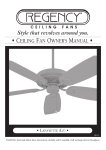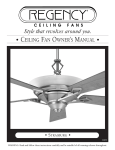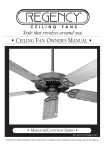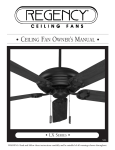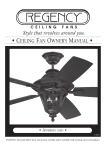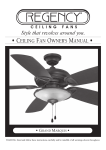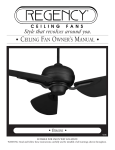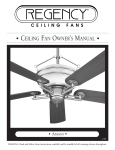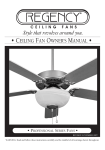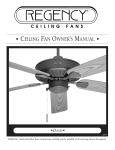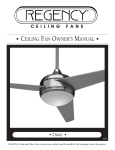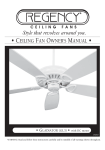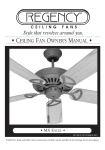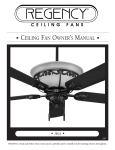Download Regency Fan Regulator Owner`s manual
Transcript
• Style that revolves around you. CEILING FAN OWNER'S MANUAL • READ AND SAVE THESE INSTRUCTIONS • REGULATOR • 09/08 WARNING: Read and follow these instructions carefully and be mindful of all warnings shown throughout. GENERAL INSTALLATION & OPERATION INSTRUCTIONS IMPORTANT SAFEGUARDS: 1. To ensure the success of the installation, be sure to read the instructions and review the diagrams thoroughly before beginning. 2. To avoid possible electric shock, be sure electricity is turned off at the main power box before wiring. All electrical connections must be made in accordance with local codes, ordinances and/or the National Electric Code. If you are unfamiliar with the methods of installing electrical wiring and products, secure the services of a qualified and licensed electrician as well as someone who can check the strength of the supportive ceiling members and make the proper installation(s) and connections. 3. Make sure that your installation site will not allow rotating fan blades to come in contact with any object. Blades should be at least 7 feet from floor. 4. WARNING: To reduce the risk of fire, electric shock, or personal injury, mount to outlet box marked "Acceptable for Fan Support of 22.7 kg (50 lbs.) Or Less" and use mounting screws provided with the outlet box. Most outlet boxes commonly used for the support of light fixtures are not acceptable for fan support and may need to be replaced. Due to the complexity of the installation of this fan, a qualified licensed electrician is strongly recommended. 5. Blades should be attached after motor housing is hung and in place. Fan motor housing should be kept in the carton until ready to be installed to protect its finish. If you are installing more than one ceiling fan, make sure that you do not mix fan blade sets, sets as each blade is part of a weighted set. 6. After making electrical connections, spliced conductors should be turned upward and pushed carefully up into outlet box. The wires should be spread apart with the common conductor and the grounding conductor on one side of the outlet box, and the "HOT" wires on the other side. 7. Electrical diagrams are for reference only. Light kits that are not packed with the fan must be UL listed and should be installed per the light kit's installation instructions. 8. After fan is completely installed, check to make sure that all connections are secure to prevent fan from falling and/or causing damage or injury. 9. The fan can be made to work immediately after installation - the bearings are adequately charged with grease so that, under normal conditions, further lubrication should not be necessary for the life of the fan. 10. Do not operate the reverse switch while the fan blades are in motion. The fan must be turned off and the blades stopped before reversing the blades direction. Weight of Fan: 30.89 Lbs 1 IMPORTANT SAFETY PRECAUTIONS Thank you for choosing a Regency Ceiling Fan. You have chosen the best! Your new ceiling fan has been designed to provide many years of service and enjoyment. Warnings: • Disconnect power by removing fuse or turning off circuit breaker before installing the fan and/or optional lighting. • Support directly from building structure. • To reduce the risk of fire, electric shock, or personal injury, mount to outlet box marked "Acceptable for Fan Support of 22.7 kg (50 lbs.) Or Less" and use mounting screws provided with the outlet box. Most outlet boxes commonly used for the support of light fixtures are not acceptable for fan support and may need to be replaced. Due to the complexity of the installation of this fan, a qualified licensed electrician is strongly recommended. • To reduce the risk of fire, electricial shock, or personal injury, only use this fan with an appropriate speed control device designed for use with ceiling fans if you use a wall control. • To reduce the risk of personal injury, do not bend the blade arms when installing them, balancing the blades or cleaning the fan. Do not insert any objects(s) between rotating fan blades. NOTE:The important precautions, safeguards and instructions appearing in this manual are not meant to cover all possible conditions and situations that may occur. It must be understood that common sense, caution and carefulness are factors which cannot be built into this product. These factors must be supplied by the person(s) installing, caring for, and operating the unit. TOOLS AND MATERIALS REQUIRED • • • • • • Phillips screwdriver Blade screwdriver Wrench or pliers Wire cutter Stepladder Wiring supplies as required by electrical code 2 UNPACKING YOUR FAN 1. Unpack your fan and check the contents. Do not discard the carton. If warranty replacement or repair is ever necessary, the fan should be returned in original packing. Remove all parts and hardware. Do not lay motor housing on its side, or the decorative housing may shift, be bent or damaged. 2. Examine all parts. You should have the following: 2 8 12 3 1 4 13 5 9 6 10 11 7 14 1. Fan blades (5) 2. Mounting bracket 3. Hanging bracket 4. Ceiling canopy 5. Canopy screw cover plate 6. Downrod/ball assembly 7. Decorative collar cover 8. Fan housing with motor (Remove and discard rubber shipping supports around motor, if included on your fan. Save screws.) 9. Blade arms (5) 10. Detachable switch housing mounting plate 11. Detachable switch housing 12. Pull chain with fob 13. Bracket mounting hardware (wood screws, screws, lock washers, washers, wire nuts) 14. Blade to blade arm screws, w/washers (20) NOTE: Design of parts shown above may look slightly different for your specific model of fan. 33 PREPARATION Parts identification on assembled fan Canopy Downrod Blade Collar Cover Motor Housing Blade arm Pull chain with fob Detachable Switch Housing PREPARATION: Verify you have all parts before beginning the installation. Check foam insert closely for missing parts. Remove motor from packing. To avoid damage to finish, assemble motor on soft padded surface or use the original foam inset in motor box. Do not lay motor housing on its side as this could result in shifting of motor in decorative enclosure. 4 INSTALLING THE MOUNTING BRACKET AND HANGING BRACKET Caution: To avoid possible electrical shock, be sure electricity is turned off at the main power box before wiring. All wiring must be in accordance with National and Local Electrical Codes and the ceiling fan must be grounded as a precaution against possible electric shock. Outlet box IMPORTANT NOTE: THIS CEILING FAN EXCEEDS THE MAXIMUM WEIGHT (35 LBS) SPECIFIED BY UL FOR HANGING FROM A STANDARD CEILING FAN RATED OUTLET BOX. SPECIAL REINFORCEMENT TO THE CEILING IS REQUIRED FOR INSTALLATION! CAUTION: Wood screws must go through the outlet box and directly into the building joist or into added cross support. (Fig. 1) Mounting bracket Knock out Flat washers Step 1. Remove the two knock-outs from the outlet box to expose the joist. If the outlet box does not have knock-outs, you will need to drill the holes. (Fig. 1) Step 2. Secure the mounting bracket directly to the joist from the building via the knock out holes from the outlet box. Secure the mounting bracket with the wood screws and lockwashers provided with the fan. (Fig. 1) Lock washers Wood screws Fig. 1 Step 3. Secure the hanger bracket to mounting bracket using the two hex nuts and washers provided, make sure nuts are securely tighten. (Fig. 2) Mounting bracket WARNING: Do not over-tighten the hex nut on the heavy duty hanging plate - properly tighten it until it is secured. Over-tightening the hex nut will result in the breakage of the bolt. Hanger bracket Flat washers Spring washers Hex nuts Fig. 1 5 INSTALLING THE FAN 1. Carefully support fan body (motor) in its styrofoam packing with the mounting collar (where the wires come out) facing upward. 2. Loosen the two set screws and remove the downrod pin and cotter pin from the top coupling of the motor assembly. 3. Remove ball from the downrod by loosening set screw in the side of the ball. Slide ball down and remove ball pin; remove ball. 4. Feed the wires from top of fan through end of the downrod of choice and set end of downrod into mounting collar so the hole in the downrod lines up with the hole in the side of the mounting collar. 5. Insert downrod pin through holes in mounting collar and downrod; slip cotter pin through small hole in end of downrod pin to hold downrod in place. 6. Tighten jam screws against downrod using a large flat blade screwdriver to ensure a tight fit against downrod. Tighten nuts against mounting collar. NOTE: Fan has 6 feet of hook-up wire in case you are using a long extension downrod. Wires can be cut so only 8 inches or so extend beyond the top of the downrod to make the electrical connections easier and safer. Hook-up (3) Wires Ground Wire Ball 7. Feed wires through collar cover and slide collar cover down the downrod to top of fan. Canopy 8. Feed wires through canopy screw cover plate and canopy, then slide both over downrod to lay on top of collar cover. It will be attached to ceiling later. Downrod Canopy Screw Cover Plate Collar Cover 9. Feed wires through ball and slide ball over downrod, past hole in the top end of the downrod. Insert ball pin (removed in step 3), slide ball up, and tighten set screw to secure ball in place. Mounting Collar Downrod Pin Top of Fan Body 6 Security Cotter Screws Pin INSTALLING THE FAN CONTINUED WARNING: To avoid damaging the blade arms and blades, do not install them onto fan until fan is fastened to ceiling. 1. Lift ball/downrod/fan into hanging bracket opening. NOTE: The tab opposite hanging bracket opening should fit in slot on ball. Tab Slot ELECTRICAL CONNECTIONS * Be sure electricity is turned off at the main power box before wiring. 1. Four wires are connected to the fan. Black - this is the "hot" power to run fan. White - this is the "common" power to run fan and light. Blue - this is the "hot" power for light kit. Green - ground wire (on bracket or downrod). 2. If fan and light are to be connected to the same circuit, black and blue wires can both be connected to house circuit black wire. NOTE: The other end of the blue wire, (light circuit) is in the switch housing with a wire nut and label for light kit attachment. The white wire (common for light kit) is also there. Fig. 2 WARNING: If light kit is not used, DO NOT connect blue wire at the ceiling. Fig. 3 Fig. 1 7 FINISHING THE INSTALLATION 1. Tuck connections neatly into ceiling outlet box. 2. Slide the canopy up to ceiling and over the 2 screws on the hanger bracket. Rotate canopy clockwise. Next, while holding the canopy with one hand, slide the canopy screw cover plate over the screws and rotate clockwise until tight. NOTE: adjust the canopy screws as necessary until the canopy and canopy screw cover plate are snug. WARNING: Make sure the hook on the hanging bracket properly sits in the groove in the hanger ball before attaching the canopy to the bracket by turning the housing until it drops into place. Ceiling Fan Outlet Box Hanger Bracket Screws Canopy Canopy Screw Cover Plate BLADE ATTACHMENT 1. Place fiber washer on screw. Insert this assembly through the blade and start the screw into the blade arm. Repeat this procedure without tightening the screw until all 3 screws have been started into the blade arm (Fig. 1). NOTE: Fans that have painted finishes are packed with gaskets that can be used between the blade arm and blade to help prevent a clicking noise that may develop if blade screws loosen over time. 2. Tighten each screw starting with center screw. 3. Fasten blade assembly to motor with provided screws and lock lockwashers. Repeat procedure for remaining blades (Fig. 2). Make sure screws are TIGHT! Loose motor screws can contribute to unnecessary hum during operation. NOTE: Cordless power screwdrivers are NOT recommended, as they tend to strip the heads of the screws and usually will not fully compress the lock washers on the motor screws. Use a large flat blade screwdriver for final tightening to fully compress the washers. This will help ensure proper alignment of the blades and noise-free, wobble-free running. Install gasket between blade arm and blade (optional) Screw Fiber Washer Screws Blade Arm Blade Blades Assembly Fig. 1 Fig. 2 8 INSTALLATION OF DETACHABLE SWITCH HOUSING MOUNTING HUB 1. Remove one of the three screws on the mounting hub located on the fan motor. 2. Loosen the other two screws. 3. Install detachable switch housing mounting hub to mounting hub. 4. Pass the 2 light wires through the center hole of the detachable switch housing mounting hub. 5. Line up the two slotted holes with the two loose screws on the mounting hub located on fan motor. 6. Re-install the third screw removed and tighten all three. Mounting Hub (bottom of motor) Detachable Switch Housing Mounting Hub Light Wires Screws 9 INSTALLING THE REMOVABLE SWITCH HOUSING NOTE: Be sure the power is off before installing. 1. Loosen the 3 side screws on detachable mounting plate halfway. 2. If installing light kit, carefully remove light kit cover in bottom of switch housing. Attach the light kit to the switch housing per instructions supplied with light kit. (Follow the instructions included with the kit.) 3. Connect the plug and receptacle and make sure side buckle snaps in place. 4. Attach the switch housing to the mounting plate. 5. Align the side screws with keyhole slots on edge of switch housing and tighten the side screws. 6. Turn the power on. Your Regency Ceiling Fan is now ready to enjoy! Detachable Switch Housing Mounting Hub Side Screw (x3) Light Wires Keyhole Slot (x3) Switch Housing Optional Light Kit connects to bottom of Switch Housing 10 OPERATION Turn on the power and check operation of the fan. The fan is controlled by the use of the pull chain as follows: one pull = high speed two pulls = medium speed three pulls = low speed four pulls = off For proper functions, ensure that the chain is pulled down fully and released each time. NOTE: Leave pull chain switch in "high speed" position when using optional wall control. The slide switch on the side of the switch housing controls forward or reverse rotation. Make sure switch is not stuck between forward and reverse positions. IMPORTANT: To prevent damage or cause injury, be sure that fan is switched to off and blades have stopped moving completely before attempting to change direction of rotation. Forward/Reverse Direction: Warm Weather (forward): A DOWNWARD airflow creates a cooling effect as shown in Figure 1. This allows you to set your air conditioner on a warmer setting without affecting your comfort. Cool Weather (Reverse): An UPWARD airflow moves warmer air off the ceiling area as shown in Figure 2. This allows you to set your heating unit on a cooler setting without affecting your comfort. Fig. 1 Fig. 2 11 CARE AND CLEANING Periodically it may be necessary to re-tighten blade to blade arm screws or blade arm to motor screws to prevent clicking or humming sound during operation. This is especially true in climates with broad temperature and humidity ranges. When dusting the blades, you must support the blade to prevent bending - no pressure should be applied to the blades. If you experience any flaws in the operation of your fan, please check the following points. TROUBLESHOOTING - IN CASE OF DIFFICULTY CAUTION: Switch off power supply before carrying out any of these checks. 1. If fan will not start: Check main and branch circuit breakers and/or fuses. Check line wire connections to fan housing wiring. Make sure forward/reverse switch is set to one or the other position, not stuck in between. 2. If fan is noisy: Check and make sure that all screws in motor housing are snug (but not over tight). Check that the screws securing blade arms to the motor are tight. Check that wire connectors in switch housing are not rattling against each other or the interior wall of the switch housing. Check that all glassware is finger tight and that bulb(s) are well held in the sockets, if a light kit is used. Check that the canopy is firmly attached to hanging bracket and not vibrating against ceiling. 3. If fan wobbles: Check that all blades are firmly screwed into blade arms. Check that all blade arms are firmly secure to the motor. Check to make sure that light kit (if present) is firmly attached to switch housing and that all glassware and shades are fastened properly. Wobble can also result from even the smallest deviations in distance from blade tip to blade tip. If measurements from blade tip to blade tip are not equal, loosen screws connecting blade to blade arm one at a time and adjust blade(s) so that distances are equal. Interchanging adjacent blades may redistribute mass and result in smoother operation. Blade arms can be bent slightly to restore same pitch to all blades if a blade is different than the other blades when viewed edge on. Most wobble can be traced to a loose electrical box or mounting bracket. Make sure these are tight and the ball is completely seated in the bracket. THANK YOU FOR PURCHASING A REGENCY CEILING FAN. Write to us at: Regency Ceiling Fans P.O. Box 730 Fenton, MO 63026 Visit us on the Web at: www.regencyfan.com 12 09/08 Regency Ceiling Fans













